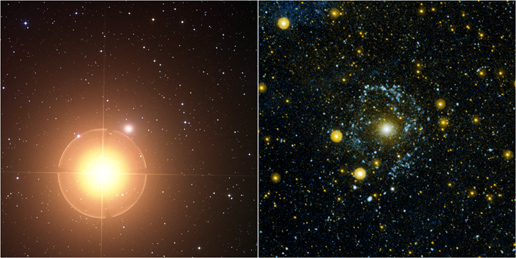[/caption]
Halloween means its time for ghost stories and here’s a mysterious astronomical story about the “Ghost of Mirach.” When viewed in visible light, as in the picture above on the left, the galaxy called NGC 404 appears as just a white blob. Mirach is a red giant star that looms large in visible light, hiding NGC 404 in its glare, and therefore was nicknamed “The Ghost of Mirach” But when the Galaxy Evolution Explorer (GALEX) spied the galaxy in ultraviolet light, a spooky ring materialized and the region came to “life.” This ring, seen in blue in the picture on the right, contains new stars — a surprise considering that the galaxy was previously thought to be dead. “We thought this celestial ghost was essentially dead, but we’ve been able to show that it has an extended ring of new stars. The galaxy has a hybrid character in which the well-known, very old stellar population tells only part of the story,” said David Thilker of Johns Hopkins University in Baltimore. “It’s like the living dead.”
Oooh, spooky!
The eerie creature, called NGC 404, is a type of galaxy known as “lenticular.” Lenticular galaxies are disk-shaped, with little ongoing star formation and no spiral arms. NGC 404 is the nearest example of a lenticular galaxy, and therefore of great interest. But, usually it lies hidden in the glare from a red giant star Mirach.
Thilker and members of the Galaxy Evolution Explorer team spotted the Ghost of Mirach in images taken during the space telescope’s all-sky survey, where it is scanning the entire visible sky in ultraviolet light, a job never before accomplished.
Long exposure observations of this region show that the NGC 404 is surrounded by a clumpy, never-before-seen ring of stars.
What is this mysterious ultraviolet ring doing around an otherwise nondescript lenticular galaxy? As it turns out, previous imaging with the National Science Foundation’s Very Large Array radio telescope in New Mexico had discovered a gaseous ring of hydrogen that matches the ultraviolet ring observed by the Galaxy Evolution Explorer. The authors of this Very Large Array study attributed the gas ring to a violent collision between NGC 404 and a small neighboring galaxy 900 million years ago.
The ultraviolet observations demonstrate that, when the hydrogen from the collision settled into the plane of the lenticular galaxy, stars began to form in a ghostly ring. Young, relatively hot stars forming in stellar clusters sprinkled throughout NGC 404’s ring give off the ultraviolet light that the Galaxy Evolution Explorer was able to see.
“Before the Galaxy Evolution Explorer image, NGC 404 was thought to contain only very old and evolved red stars distributed in a smooth elliptical shape, suggesting a galaxy well into its old age and no longer evolving significantly,” said Mark Seibert of the Observatories of the Carnegie Institution of Washington in Pasadena, Calif. “Now we see it has come back to life, to grow once again.”
“The Ghost of Mirach has been lucky enough to get a new lease on life through the rejuvenating, chance merger with its dwarf companion,” added Thilker.
The findings indicate that the evolution of lenticular galaxies might not yet be complete. They may, in fact, continue to form stars in a slow, piecemeal fashion as they suck the raw, gaseous material for stars from small, neighboring galaxies. It seems the Ghost of Mirach might act more like a vampire than a ghost.
The fields of view are identical in both pictures, and spans 55,000 light years across. The Ghost of Mirach is located 11 million light-years from Earth. The star Mirach is very close in comparison — it is only 200 light-years away and is visible with the naked eye.
Source: NASA


Amazing, it’s almost like stars hiding in plain sight! Sometimes it’s not where you look but how you look! (hmmm, that almost sounds conceited doesn’t it?)
I believe the paper to which you are referring to in regards to NGC 404’s HI excess is ‘High-Resolution Observations of the Galaxy NGC 404: A Dwarf S0 with Abundant Interstellar Gas’ by MS del Rio et al published in the Astrophysical Journal in 2004 (http://tinyurl.com/5lmhaz). In this paper, pg 10 has a remarkable side by side view of comparably sized fields around NGC 404 (both containing Mirach, BTW) one from the Palomar Sky Survey and the other from the VLA radio telescope. The radio view is eerily similar to the GALEX UV view! In the paper, the authors propose several explanations for this ring of neutral hydrogen, one being that simply no stars formed from it! (Clearly a moot point now with the GALEX observation). Also mentioned is the possibility of NGC 404 disrupting a nearby gas-rich dwarf galaxy. But clearly the jury is still out on this peculiar finding in a galaxy long thought to have given up the ghost.:)
The paper is available at arXiv:astro-ph/0403467. Sorry for the broken link.
In the 2004 paper mentioned above, the authors found that the mass of the external HI ring was on the order of 38 million solar masses and slightly inclined to the plane of rotation of NGC 404. What I find curious is that if vigorous star & cluster formation is evident in far-UV observations presumably from this HI disk, why are no hydrogen-alpha (H-a) regions observed as would be expected when hi-energy radiation from these young objects should profusely produce H-a star forming regions?